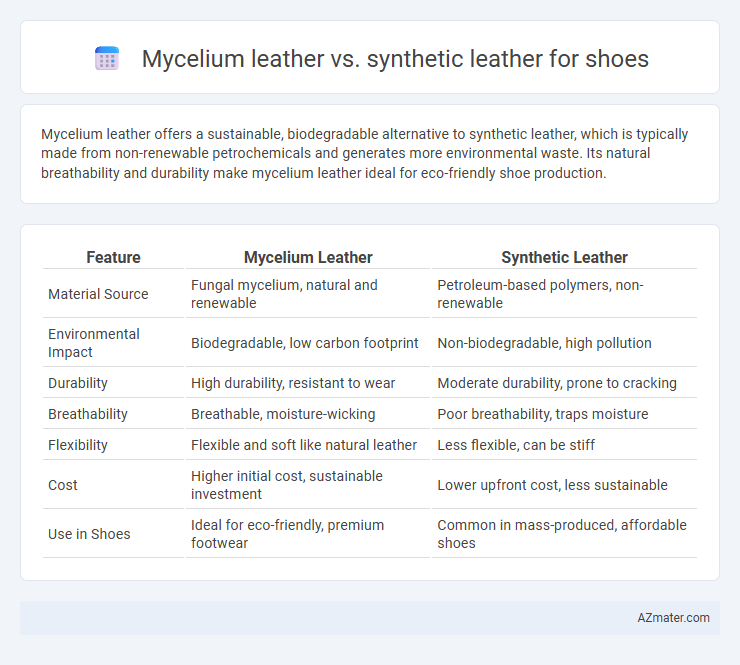Mycelium leather offers a sustainable, biodegradable alternative to synthetic leather, which is typically made from non-renewable petrochemicals and generates more environmental waste. Its natural breathability and durability make mycelium leather ideal for eco-friendly shoe production.
Table of Comparison
| Feature | Mycelium Leather | Synthetic Leather |
|---|---|---|
| Material Source | Fungal mycelium, natural and renewable | Petroleum-based polymers, non-renewable |
| Environmental Impact | Biodegradable, low carbon footprint | Non-biodegradable, high pollution |
| Durability | High durability, resistant to wear | Moderate durability, prone to cracking |
| Breathability | Breathable, moisture-wicking | Poor breathability, traps moisture |
| Flexibility | Flexible and soft like natural leather | Less flexible, can be stiff |
| Cost | Higher initial cost, sustainable investment | Lower upfront cost, less sustainable |
| Use in Shoes | Ideal for eco-friendly, premium footwear | Common in mass-produced, affordable shoes |
Introduction to Mycelium and Synthetic Leather
Mycelium leather, derived from the root structure of fungi, offers a sustainable and biodegradable alternative to traditional materials, making it a popular choice for eco-conscious footwear brands. Synthetic leather, composed primarily of polyurethane or polyvinyl chloride, replicates the appearance of genuine leather but relies on petrochemicals, raising environmental concerns due to its non-biodegradable nature. Advances in mycelium cultivation allow for customizable textures and durability, positioning it as a cutting-edge material in comparison to conventional synthetic leather used in shoe manufacturing.
Production Processes Compared
Mycelium leather is produced through the cultivation of fungus mycelium, which grows into a sustainable material using minimal water and energy, whereas synthetic leather is typically manufactured from petrochemical-based plastics like polyurethane or polyvinyl chloride, involving energy-intensive processes and toxic chemical treatments. The mycelium production process offers biodegradability and lower carbon emissions compared to synthetic leather's reliance on non-renewable resources and longer decomposition times. Mycelium leather's eco-friendly manufacturing contrasts sharply with synthetic leather's environmental footprint, influencing sustainable fashion trends and consumer choices.
Environmental Impact and Sustainability
Mycelium leather, derived from fungal networks, offers a biodegradable and carbon-negative alternative to synthetic leather, which is primarily petroleum-based and non-biodegradable. The production of mycelium leather consumes less water and generates lower greenhouse gas emissions compared to synthetic counterparts, contributing to reduced environmental footprint in the footwear industry. Sustainable sourcing and the ability to recycle or compost mycelium leather further enhance its appeal as an eco-friendly material over synthetic leather.
Material Performance and Durability
Mycelium leather offers superior breathability and biodegradability compared to synthetic leather, enhancing comfort and environmental sustainability in shoe manufacturing. Synthetic leather provides high water resistance and consistent durability, often outperforming mycelium in longevity under heavy wear conditions. Both materials require different care approaches, with mycelium leather benefiting from gentle maintenance to preserve its natural fibers, while synthetic leather withstands harsher cleaning methods without significant degradation.
Comfort and Breathability Factors
Mycelium leather offers superior breathability compared to synthetic leather due to its natural, porous structure that allows better air circulation and moisture wicking, enhancing foot comfort. Synthetic leather, typically made from plastics like polyurethane, tends to trap heat and sweat, leading to reduced breathability and potential discomfort during extended wear. The natural texture of mycelium leather also adapts better to foot movements, providing a more comfortable and flexible fit than the often rigid synthetic alternatives.
Aesthetics and Design Versatility
Mycelium leather offers unique textures and natural patterns that enhance the aesthetic appeal of shoes with an organic, eco-friendly look, while synthetic leather provides consistent color and smooth surfaces ideal for bold, uniform designs. Design versatility in mycelium leather allows for customizable finishes and breathability, making it suitable for innovative, sustainable footwear styles. Synthetic leather excels in shape retention and a wide color palette, supporting mass production and more traditional fashion trends.
Cost Analysis for Footwear Manufacturing
Mycelium leather offers a cost-effective alternative to synthetic leather in footwear manufacturing due to its lower raw material and production expenses, as it grows rapidly using agricultural byproducts. Synthetic leather, often derived from petroleum-based polymers, involves higher energy consumption and fluctuating material costs influenced by oil prices. Manufacturers benefit from reduced environmental impact and potential subsidies linked to mycelium leather, enhancing its cost-efficiency compared to the traditional synthetic options.
Biodegradability and End-of-Life Options
Mycelium leather offers superior biodegradability compared to synthetic leather, breaking down naturally within months due to its organic fungal structure, reducing landfill impact significantly. Synthetic leather, typically made from petroleum-based plastics like PU or PVC, can take centuries to decompose, causing long-term environmental pollution. End-of-life options for mycelium leather include composting and biological recycling, whereas synthetic leather mostly faces incineration or landfill disposal, contributing to microplastic contamination.
Consumer Perception and Market Trends
Mycelium leather is gaining traction among eco-conscious consumers who prioritize sustainability and biodegradability, contrasting with synthetic leather often criticized for its environmental impact and reliance on petroleum-based materials. Market trends indicate a rising demand for mycelium leather in premium and innovative footwear segments due to its natural origin and unique texture, whereas synthetic leather maintains dominance in mass-market shoes due to affordability and durability. Consumer perception increasingly favors mycelium leather as a symbol of ethical fashion and innovation, pushing brands to adopt this material to capture younger, environmentally aware demographics.
Future Potential in the Footwear Industry
Mycelium leather offers a sustainable alternative to synthetic leather, with its rapid biodegradability and lower environmental footprint, making it a promising material for future footwear innovation. Its adaptability to various textures and durability positions it as a viable option for eco-conscious shoe manufacturers aiming to reduce reliance on fossil-fuel based synthetic materials. As technological advancements improve scalability and cost-efficiency, mycelium leather is expected to gain significant market share in the sustainable footwear industry.

Infographic: Mycelium leather vs Synthetic leather for Shoe
 azmater.com
azmater.com